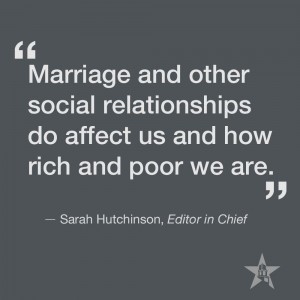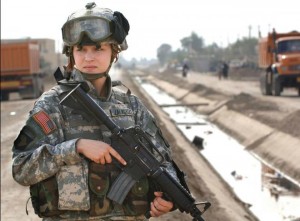“Marriage” is a hard topic to broach in public debate, particularly in the context of economics. Many women, like myself, view it with a certain amount of trepidation when the subject comes up; the floodgates seem to be open to derogatory comments about “welfare queens” and single-motherhood, with poor women bearing the brunt of poorly-disguised scorn and highly insensitive gaffes. The conversation and ensuing media rigamorale can be so off-putting.
 However, it’s not a conversation that we should tune out. Some have suggested that the collapse of the married, two-parent family – the result of decades of rising divorce rates, out-of-wedlock births, and rising numbers of couples who do not marry – has resulted in much of the poverty we see today.
However, it’s not a conversation that we should tune out. Some have suggested that the collapse of the married, two-parent family – the result of decades of rising divorce rates, out-of-wedlock births, and rising numbers of couples who do not marry – has resulted in much of the poverty we see today.
Indeed, Senator Marco Rubio (R-FL) recently made bold a speech on the fifty year anniversary of the War on Poverty in which he said “The truth is, the greatest tool to lift children and families from poverty is one that decreases the probability of child poverty by 82%. But it isn’t a government spending program. It’s called marriage.”
I would agree with Rubio, though with a few objections. To begin with, I don’t think marriage is a panacea to the current economic climate. (Granted, it’s not clear that in context of his speech that Rubio was assuming that it was.) I’m not even sure that it’s “the greatest” tool to combat poverty, either. That lends itself too much to a messianic definition of marriage, which I don’t think is appropriate. (It also seems to cheapen other equally important strategies to combat poverty.)
However, whether we like it or not, marriage and other social relationships do affect us and how rich and how poor we are. As Nick Schultz of the American Enterprise Institute points out in “Home Economics: the Consequences of a Changing Family Structure,” economics is not solely a study of numbers and monetary transactions. The most important economic questions of our time – rising income inequality, depressed wages, and slow economic growth – cannot be answered without touching upon our social institutions. If this is the case, marriage must be addressed.
Marriage delivers on a number of good things that can help relieve poverty. For one, it seems to promote economic mobilization. Our modern version of marriage has all the promise to provide a stable home for children, helping them succeed later in life. Though they acknowledge that the effects of marriage are not the only factor, a new Brookings Institution study makes the claim that “children born into continuously married family [sic] have much better economic mobility than those in single parent families.” So, marriage seems to be good for the kids.
It’s also good for the adults. In the absence of marriage, single parents, particularly single moms, have to struggle working one or more job, along with the regular housework and childrearing. According to a study undertaken by the Atlantic, poor women and single moms are more likely to have higher levels of anxiety, to live with regret, to stress about their kids, and rely on their family and friends for money. Marriage can relieve some of the pressure by turning one income into two.
Altogether, marriage creates a miniature economy that has the potential to benefit all parties and, in the best marriages, this is fueled by a love and warmth that cannot be reproduced elsewhere.
That being said, the solution to poverty in the United States can’t just be “get married,” nor should we expect that to be the solution for every individual. However, marriage is nonetheless an important aspect to resolving poverty and one of our greatest tools. Given its benefits, why don’t we encourage it enough? Let’s stop tuning out the conversation based on political rhetoric and start looking at marriage as the great thing that it is.

